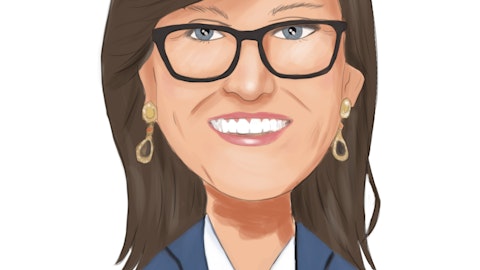So, some states have been faster, but I think most have generally been the following calendar year. So, I think we’re looking at 2024, and as I mentioned, we’ve built in some assumption around that, but this would be a bigger iGaming market than we had assumed.
David Katz: And just to follow that up, if I may. Is it a fair assumption that the negative impact, both to earnings and like New York. So we’ve acquired hundreds and hundreds of thousands of players in New York already. I think the cross-sell opportunity there would be enormous. We know that some of these players are going to Connecticut, to New Jersey, to Pennsylvania to do iGaming now. So, I do think there is some incremental customer acquisition spend, but it’s not the same as a fresh market where we haven’t had hundreds of thousands of customers that we’ve acquired already. So it’s an accurate assessment, I think.
Operator: Thank you. One moment. We have a question from Jason Bazinet with Citi. Your line is open.
Jason Bazinet: I just have a high-level question. You guys, obviously, are making a lot of progress improving the operations, and every metric seems to be moving in the right direction. At the highest level, when you think about how these improvements compare to some of the long-term targets that you’ve laid out at prior Investor Days, is the implication that the goals are the same, but you’ll just maybe get there faster? Or do you — if things keep going as well, is there scope for some of those to move up?
Jason Robins: That’s a great question. We will, later this year, be providing an updated long-term outlook at an Investor Day. So stay tuned for that. But speaking to it conceptually, I do think there’s some upside there. We certainly have some upside on the hold rate front. I think promotions will probably end up somewhere in line with where we think they’ll be long term. And then on the cost side, I think there’s always effort that needs to be going. That’s something, I think, that really has resonated with the team is, yes, obviously, we’re all cognizant of the market environment we’re in. But we also understand that to build the most profitable long-term company, we need to be as efficient as we possibly can. And that’s a message that everyone on leadership has really taken to.
The Board conducted a thorough review of management incentives towards the end of 2021 and starting in ’22, it’s continued to ’23, completely realigned management incentives. So, there was an equivalent focus on EBITDA and profitability to what we previously had, had on revenue. So I think that when we look at the long term, and like I said, we’ll provide more specific updates later this year, I do think there’s some upside if we can continue to find the efficiencies that we’ve been finding over the past 12 months.
Operator: Thank you. And our next question comes from Carlo Santarelli with Deutsche Bank. Your line is open.
Carlo Santarelli: Jason, whoever wants to take this one, as you guys think about kind of the structural hold improvements that you’re making and you think about kind of the new parlay product, relative to retention and acknowledging, it’s early with a lot of this stuff, but you obviously had some growth over the course of 2022 with your addressable TAM, with new states that have come online. I believe your monthly unique payers, was up high 20s this year. I’m not sure if that is in line with kind of the addressable TAM that you brought up, but it seems similar, at least. As you think about like kind of that retention effort, as holds are rising, how could you kind of comment around the balance between how to retain and kind of how to improve efficiency on a per customer basis?





